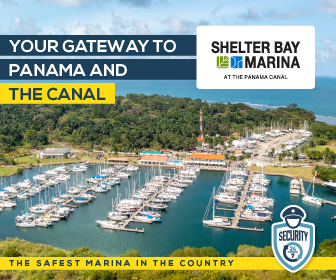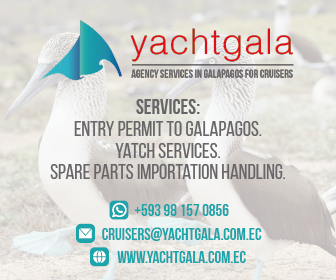Panama Canal Transit – Cruisers Notes
Published 15 years ago, updated 6 years ago
CRUISER NOTES ON HOW TO TRANSIT THE CANAL ON A PRIVATE YACHT
By Seth Hynes of SY Honeymoon (a Lagoon 380) who transited the Panama Canal in March 2009.
1) DO NOT HIRE Y&J; YACHTS AS YOUR CANAL AGENT:
The CEO of Y&J; Yachts, Ms Yara Mandrian, is running a scam. We recommend that you DO NOT HIRE this agency. We were not returned our buffer of $850 USD as they claimed to have lost the money to a greedy partner. While they did successfully get us through the canal, they are now claiming to be near bankrupt and are unable or unwilling to transfer us the money that is owed to us. We have been in contact with the ACP Canal Authority and this agent will soon be stripped of their license. Any boats with payments already made will lose their money. Please avoid this agent – if you have to choose one, please use a highly recommended and proven agent, regardless of cost.
(Editor’s Note: Y&J; Yachts were not found via noonsite as they are not listed. No yacht should appoint an agent in Panama without having references.)
2) SHOULD I USE AN AGENT:
In our experience seeing several yachts go through the canal we would STRONGLY RECOMMEND that you DO NOT use an agent. We used one as we had concerns that the canal would be backed up like last year and we were meeting guests in the Galapagos, so we had to transit quickly. What we found was that the canal is now operating at normal time frames of approximately 4-5 days wait once you are Admeasured. Additionally, our agent only managed to delay our transit through her failure to complete the paperwork on-time and she stole our buffer of $850 (which was never returned). We found the lack of information online frightening and figured we would hire an agent, but it was a huge mistake given how simple it was for other yachts to manage the transit themselves.
3) HOW TO DO IT YOURSELF:
When you arrive at the Shelter Bay Marina (or another anchorage in Colon), take a taxi to the admeasure office in Colon. Even if you don’t speak Spanish, the cab driver will know the “admeasurer office.” Once inside, everyone speaks sufficient English, there is usually no wait and you can normally schedule your admeasure date for the next day. The measuring process is easy and very straightforward. At the arranged time the admeasurer will arrive at your boat and take a measurement of the boat (complete of all protrusions, like davits, etc). Once you are measured you take one final taxi to the “ACP transit office” to pay. The last step is to call an English speaking manager over the phone to receive your actual transit date and time. To pay an agent anywhere from $300 to $500 to do this seems rather wasteful in comparison. While Colon is definitely a dangerous town, you are not going there at night and the taxi drivers are very helpful and know exactly where to take you.
4) WHY NOT USE AN AGENT:
Although our experience may have been unlucky, we had huge problems with our agent. After waiting the normal time for our transit date we were out on the flats anticipating the arrival of our adviser and he never showed. It seems our agent failed to pay the canal in time, despite us paying her with a credit card six days before. We were then at the agent’s mercy as we had no way to help her speed up her payment to the transit office. We were then almost delayed an additional 5 days by the transit authority for the error, but somehow we slipped into a spot that opened up. And if this was not stressful enough, our agent never refunded us our buffer of $850 USD! She claimed that her partner stole the money and although she wanted to pay us back she would not be able to do so. We are now in the process of working with the ACP canal authority to strip her of her license, however, she is still operating and last we heard the Moorings was using her to transit a vessel to the South Pacific. It has all been very frustrating and in the end, we waited two days longer than anyone else and paid four times as much all because we were relying on someone else to do what is really fairly easy to do yourself.
5) TYRES AND LINE HANDLERS:
Another question was whether or not to purchase/rent tires and local line handlers. We were lucky and were given 16 tires by a boat we met that had just crossed from the Pacific, but in general, it seems that tires cost $3 each and you will need to wrap them in plastic garbage bags to keep them from marking your boat. Be careful as some of them have been worn down to the metal rings and you can easily cut your hands on them. When in Panama City you will likely have to pay a further fee to get rid of them.
Line Handlers were charging a rate of $65 per person, per day. This included the line rentals, which you can otherwise rent independently for a fee of $20. We heard that it was best to hire local line handlers as they can speak in Spanish with the Adviser and the line handlers on the lock walls, but this was really not necessary. I would recommend that you find some sailors in the marina and have them line handle for you for free. You will likely need to house them overnight in the lake, so dinner and breakfast will also be required. This is what we did and their lack of experience was not a problem as the actual transit was much easier than expected.
6) WHAT IS THE BEST POSITION IN THE LOCKS:
There are three alternatives for crossing. You can transit in the centre using your likes to keep you off the walls. You can tie up to the Tug Boat transiting with a larger ship. Or you can tie directly to the wall yourself. Obviously, the latter of the three is the worst option as you want to stay as far away from the walls as possible, but in our opinion, either of the first two methods works fine. Tying up with the Tug is probably the safest method, but you have to tie up each time you enter a new lock (of which there are six). For this reason, tying up with another boat and transiting in the middle might actually be the easiest as you can remain tied as you motor to the next lock. And if you are lucky (as we were), you will tie up with a larger boat that does all the manoeuvring for you. This is especially true if they have a strong bow thruster. In the end, you really don’t get to choose anyway, but knowing about each method should help.
7) WHERE TO STAY:
We stayed at the Shelter Bay Marina on the Atlantic side (outside Colon) and in the Flamenco Marina Harbor Anchorage on the Pacific Side (outside Panama City). We found Shelter Bay a very nice place to stay with excellent internet service covering the entire marina. The rates were expensive, but the marina provided daily buses to the large grocery store outside of Colon for a minimal fee. Additionally, we met many other boats and were able to easily secure line handlers for our transit (saving us a lot of money). Most importantly, the marina is VERY safe given its location a good 45 minutes outside of town.
In the Pacific, we were very disappointed with the Flamenco Marina. The rates were outrageous and the services terrible. The marina is not well protected from swell and is more set up to host the local sports fishing boat fleet, not cruisers. We found the anchorage outside the marina much more conducive for what we needed, although the wake from passing tankers did get old after a while. There is a small dinghy dock that you can tie up to near the Abernathy Marine Store and taxis are readily available to take you to town. The going rate for a taxi was $10 an hour or $5 to the closest grocery store. Again, safety was a concern and the anchorage felt well protected and safe against theft, etc. We cannot say much about the Flats anchorage (outside Colon) other than it looked rolly due to the passing tankers and that there was no internet service.
If you have other questions, send me an email and good luck with your crossing.
Seth Hynes
seth_hynes@yahoo.com
Related to following destinations: Panama








